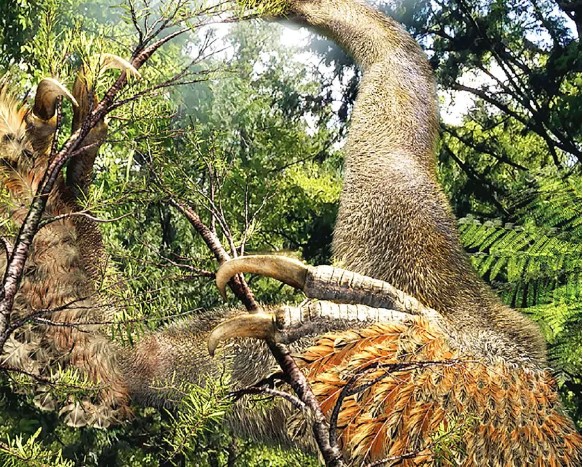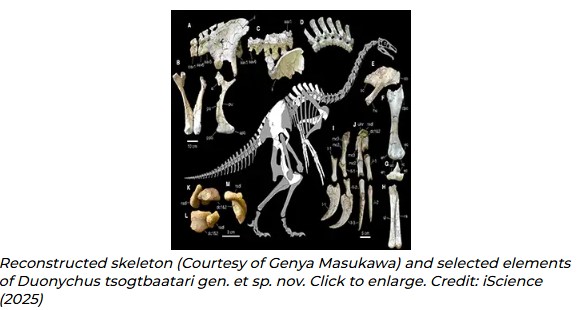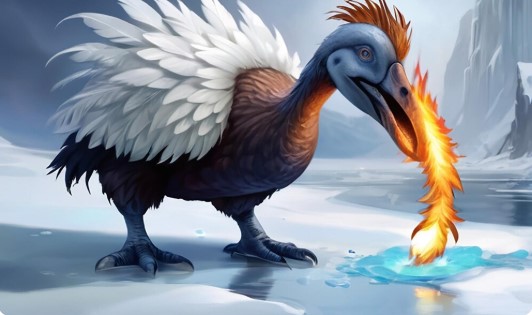Dinosaur species discovered with just two claws, baffling scientists

A newly found dinosaur is drawing attention and raising eyebrows because of its arms that resembled barbecue tongs and claws that are almost the size of a human forearm.
This strange animal, which looked like a cross between a sloth, a giraffe, and Edward Scissorhands, lived on Earth millions of years ago. We are now gaining a far better understanding of its peculiar anatomy thanks to an amazing fossil discovery in Mongolia.
This strange animal, which looked like a cross between a sloth, a giraffe, and Edward Scissorhands, lived on Earth millions of years ago. We are now gaining a far better understanding of its peculiar anatomy thanks to an amazing fossil discovery in Mongolia.
Did you know? You can comment on this post! Just scroll down
Discovery of a two-clawed dinosaur
Because of its remarkable claws, the dinosaur, which was found by paleontologists from the University of Calgary and Mongolia's Institute of Paleontology, has been called Duonychus tsogtbaatari. In Greek, "duonychus" signifies "two claws."
The exceptional preservation of a claw sheath composed of keratin, the same substance as our fingernails, is what distinguishes this discovery. The dinosaur's claw was significantly longer than its bone structure would have indicated, as the sheath demonstrates. According to paleontologist Darla Zelenitsky, an associate professor at the University of Calgary in Canada, "it's about a foot (30 cm) in size." "With its keratinous sheath, this is by far the largest claw that has been preserved for a dinosaur."
The exceptional preservation of a claw sheath composed of keratin, the same substance as our fingernails, is what distinguishes this discovery. The dinosaur's claw was significantly longer than its bone structure would have indicated, as the sheath demonstrates. According to paleontologist Darla Zelenitsky, an associate professor at the University of Calgary in Canada, "it's about a foot (30 cm) in size." "With its keratinous sheath, this is by far the largest claw that has been preserved for a dinosaur."
Big claws, but not so ferocious
Duonychus tsogtbaatari was a member of the theropod family, which includes the therizinosaur group of dinosaurs. Tyrannosaurus Rex is a member of this family as well. During the Cretaceous Period, a group of herbivorous/omnivorous theropod dinosaurs known as therizinosaurs inhabited both Asia and North America. The researchers observed that these theropods are distinguished by their huge claw-like unguals on their three-fingered hands.
Unlike most theropods, which were primarily carnivorous, therizinosaurs evolved into plant eaters, with adaptations such as a small head, a beak-like mouth, and leaf-shaped teeth suited for processing vegetation.
Their most striking characteristic was their massive claws, which could reach up to a meter in length and were likely used for defense and foraging.
Fossils of therizinosaurs, such as Therizinosaurus from Mongolia, have revealed a fascinating evolutionary history that connects them to other theropods, despite their unusual anatomy.
The therizinosaur lineage is closely related to feathered dinosaurs and even modern birds, with evidence suggesting that they were covered in feathers, which may have played a role in insulation or display.
A surprising discovery
“Here, we describe a new and unusual species of the therizinosaurid Duonychus tsogtbaatari, recovered from the lower Upper Cretaceous Bayanshiree Formation of the Gobi Desert of Mongolia,” wrote the researchers.
Standing about 10 feet (3 meters) tall and weighing around 573 pounds (260 kilograms), Duonychus likely used its massive claws to forage by grasping tree branches and pulling down vegetation.

Its hands had only two large fingers, which is an oddity among dinosaurs. While scientists believe those claws were mainly used to grab plants, they may have also served other purposes – like showing off or defending against threats.
“They weren’t predators, but they could defend themselves with those claws. They were big and very sharp,” said Zelenitsky.
Like sloths, but with attitude
The best modern comparison for these claws might be found in sloths, whose curved nails help them cling to tree limbs, noted Zelenitsky. But Duonychus adds a prehistoric twist.
The preservation of the keratin sheath is a rare scientific win. Most dinosaur fossils don’t include this detail, which makes the discovery particularly valuable.
“I’ve seen fragments from other specimens from the Gobi, but never a whole sheath like this,” said David Hone, a paleontologist at Queen Mary University of London, who was not part of the study.
“The kind of preservation here, which is common to the vast majority of dinosaur bearing formations, doesn’t usually preserve keratin.”
Hone emphasized that there’s a murky relationship between the bone and keratin structures, so this specimen helps scientists understand better how the claw really looked and functioned.
Two-clawed dinosaur with giant arms
Therizinosaurs are often compared to the character Edward Scissorhands, thanks to their long, scythe-like claws. Duonychus takes the comparison even further, with its two-fingered limbs.
“But this one is unique in having only two fingers on each of its giant arms, so they really do look like oversized tongs you might use when barbequing,” said Steve Brusatte, a professor of paleontology at the University of Edinburgh who was not involved in the study.
Two-fingered dinosaurs were relatively rare. While T. rex also had just two fingers, its stubby arms weren’t all that useful. In contrast, Duonychus used its limbs actively in daily life, especially when it came to feeding.
Localities of Late Cretaceous therizinosaurs and excavation of Duonychus tsogtbaatari gen. et sp. nov. Click to enlarge. Credit: iScience
“But whereas T. rex probably wasn’t using its pathetic little arms for much, and definitely not for combat or subduing prey, these therizinosaurs were using them as an integral part of their feeding strategy,” said Brusatte.
A dinosaur like no other
The fossil was uncovered in Mongolia’s Gobi Desert and included not just the iconic claws but also parts of the spine, tail, hips, arms, and legs.
This gives paleontologists a much more complete view of the dinosaur’s overall structure. And like other therizinosaurs, it likely had feathers, adding yet another layer to its strange appearance.
"If we hadn't discovered its fossils, we wouldn't have believed that this amazing new dinosaur ever existed," Brusatte added.
With its feathery body, clumsy walk, and claws that resemble sloths, Duonychus tsogtbaatari serves as a reminder that the past was much more bizarre and fascinating than we might have thought.
The online journal iScience released the study's details.
Like what you read? For interesting stories, unique content, and the most recent updates, sign up for our newsletter.
Check us out on EarthSnap, a free app developed by Earth.com and Eric Ralls.
With its feathery body, clumsy walk, and claws that resemble sloths, Duonychus tsogtbaatari serves as a reminder that the past was much more bizarre and fascinating than we might have thought.
The online journal iScience released the study's details.
Like what you read? For interesting stories, unique content, and the most recent updates, sign up for our newsletter.
Check us out on EarthSnap, a free app developed by Earth.com and Eric Ralls.
Article Posted 2 Months ago. You can post your own articles and it will be published for free.
No Registration is required! But we review before publishing! Click here to get started

















